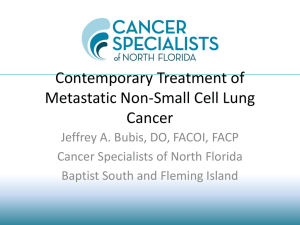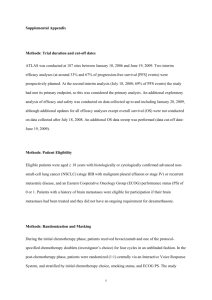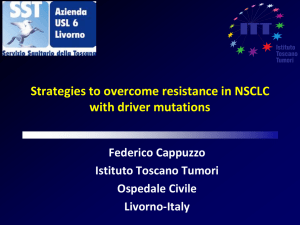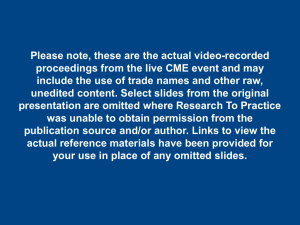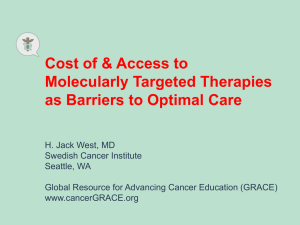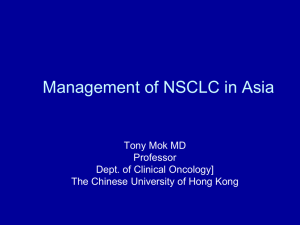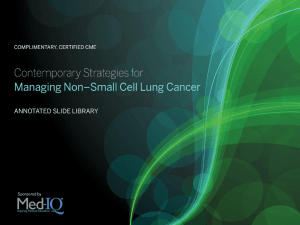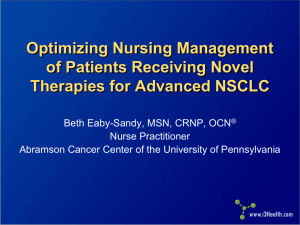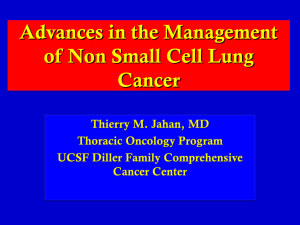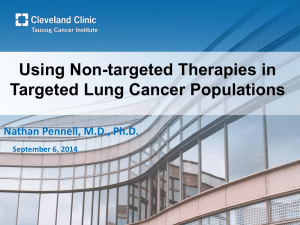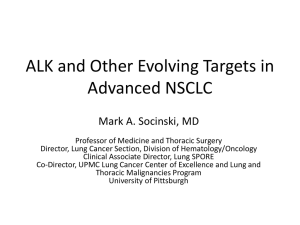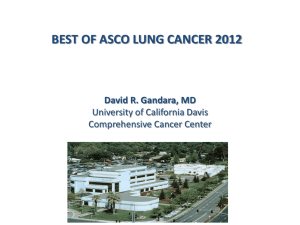PowerPoint slides - Research To Practice
advertisement
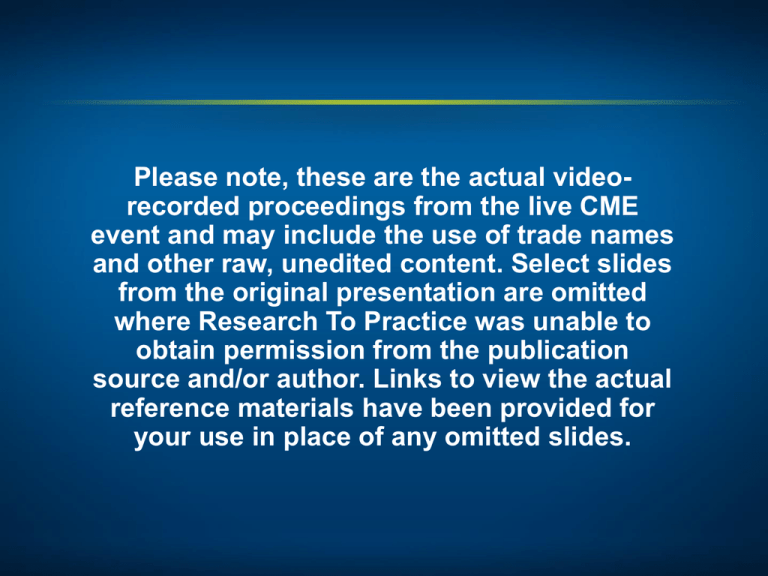
Please note, these are the actual videorecorded proceedings from the live CME event and may include the use of trade names and other raw, unedited content. Select slides from the original presentation are omitted where Research To Practice was unable to obtain permission from the publication source and/or author. Links to view the actual reference materials have been provided for your use in place of any omitted slides. Challenging Cases in Lung Cancer Oncologist and Nurse Investigators Consult on Actual Patients from the Practices of the Invited Faculty Friday, April 26, 2013 6:30 AM – 8:00 AM Washington, DC Faculty Ann Culkin, RN, OCN Beth Eaby-Sandy, MSN, CRNP, OCN Moderator Neil Love, MD Rogerio C Lilenbaum, MD Lecia V Sequist, MD, MPH Challenging Cases Oncologist and Nurse Investigators Consult on Actual Patients from the Practices of the Invited Faculty Themes — Challenging Cases in Oncology A 10-Hour Integrated Curriculum • Challenges associated with the incorporation of new research findings and newly approved agents into practice • Patient education on potential risks and benefits of specific oncologic treatments • Monitoring and management of treatment side effects and toxicities Themes — Challenging Cases in Oncology A 10-Hour Integrated Curriculum • Participation in ongoing clinical trials as an important patient option • Psychosocial impact of cancer diagnosis and treatment — why all patients, even those with the same disease, are different • Strategies to cope with the stress of being an oncology professional Agenda Module 1: Care of patients with EGFR mutations - 55 yo woman and never smoker presents with EGFR mutation-positive metastatic lung adenocarcinoma — Ms Culkin Module 2: Chemobiologic therapy in the front-line and maintenance settings - 51 yo woman and previous heavy smoker with pan-wild-type metastatic lung adenocarcinoma — Ms Eaby-Sandy - 61 yo factory manager with progressive metastatic NSCLC through multiple lines of therapy is now responding to nab paclitaxel — Ms Eaby-Sandy Agenda Module 3: ALK- and ROS1-Positive NSCLC - 54 yo owner of a company is undergoing crizotinib therapy after being diagnosed with EML4-ALK translocation-positive lung adenocarcinoma — Ms Culkin New Agents/Regimens Recently Approved by the FDA Cancer Type Colorectal Agent Approval Date Bev on progression 1/13 Regorafenib 9/12 Aflibercept Enzalutamide Cancer Type NHL: T-cell lymphoma Nab paclitaxel 10/12 Crizotinib 8/11 T-DM1 2/13 Everolimus 7/12 Pertuzumab 6/12 Eribulin 11/10 Pomalidomide 2/13 Carfilzomib 7/12 Lung 8/12 8/12 Abiraterone 4/11 Cabazitaxel 6/10 Sipuleucel-T 4/10 Brentuximab vedotin 8/11 Romidepsin 11/09 Pralatrexate 9/09 Breast Prostate NHL: ALCL Agent Approval Date Multiple myeloma www.fda.gov MODULE 1: Care of Patients with EGFR Tumor Mutations Case (from the practice of Ms Culkin) • 55 yo married woman (never smoker) with children in college presents in October 2012 with a cough and wheezing • Workup reveals a primary EGFR-mutant (exon 19 del) adenocarcinoma with lung, brain, liver and bone metastases • Erlotinib was administered and complete response observed in all sites, despite moderate rash and diarrhea • The patient’s daughters are concerned that the EGFR “mutation” is hereditary, putting them at risk for lung cancer Incidence of Single Driver Mutations NO MUTATIONS DETECTED 40% K-RAS 24% EGFR 24% NRAS AKT1 MEK1 HER2 BRAF DOUBLE PIK3CA MET MUTANTS EML4-ALK 8% AMP Kris MG et al. 12th Annual Targeted Therapies in Lung Cancer 2012 Selection of first-line therapy for patients with EGFR mutation-positive NSCLC Phase III EURTAC Study Design • Chemonaїve Erlotinib • Stage IIIB/IV NSCLC • EGFR exon 19 deletion or exon 21 L858R mutation • ECOG PS 0-2 R (n = 174) Primary endpoint • Progression-free survival (PFS) Rosell R et al. Lancet Oncol 2012;13(3):239-46. PD Crossover Platinum-based doublet chemotherapy PD EURTAC: Response, PFS and OS Erlotinib (n = 86) Chemotherapy (n = 87) 58% 15% Median progression-free survival 9.7 mos 5.2 mos Median overall survival 19.3 mos 19.5 mos Overall response (CR + PR) Crossover effect? Rosell R et al. Lancet Oncol 2012;13(3):239-46. EURTAC: Select Grade ≥3 Adverse Events (AEs) Select Grade ≥3 AEs Erlotinib (n = 84) Chemo (n = 82) Treatment-related AEs 45% 67% Rash 13% 0% Neutropenia 0% 22% Anemia 1% 4% Increased aminotransferase 2% 0% Treatment-related deaths 1% 2% Rosell R et al. Lancet Oncol 2012;13(3):239-46. Strategies to effectively manage the dermatotoxicity associated with EGFR-directed therapy Skin Rash from Tyrosine Kinase Inhibitors • Most frequent dermatologic side effect reported is acneiform eruption. • Affects mainly face, upper chest and/or back. • Also known as acne, acneiform skin reaction/rash, follicular rash, and maculopapular skin rash. Ricciardi S et al. Clin Lung Cancer 2009;10(1):28-35. Clinical Grades of Erlotinib-Induced Rash • Mild – Generally localized papulopustular reaction – Minimally symptomatic – No impact on daily activities – No sign of superinfection • Moderate – Generalized papulopustular reaction – Mild pruritus or tenderness – Minimal impact on daily activities – No sign of superinfection • Severe – Generalized papulopustular reaction – Severe pruritus or tenderness – Significant impact on daily activities – Potential for superinfection or has become superinfected Saif MW et al. JOP 2008;9(3):267-74. Prophylaxis of Dermatologic Toxicities with EGFR Inhibitors Within first 6 weeks of EGFR TKI administration • Employ proactive approach • Thick, alcohol-free emollient cream • Sunscreen ≥SPF15, preferably with zinc oxide or titanium dioxide • Good hygiene Lynch TJ et al. Oncologist 2007;12:610-21. Management of Dermatologic Toxicities with EGFR Inhibitors • Hydrocortisone 2.5% cream • Clindamycin 1% gel • Pimecrolimus 1% cream • Doxycycline 100 mg BID • Minocycline 100 mg BID • Methylprednisolone dose pack • Erlotinib dose reduction or discontinuation Lynch TJ et al. Oncologist 2007;12:610-21. Erlotinib versus Afatinib Erlotinib Afatinib • Oral • FDA approved • Reversible EGFR TKI • Oral • Investigational agent - Granted FDA priority review 1/2013 • Irreversible ErbB family blockade - Activity against T790M mutation Common side effects • Diarrhea • Rash/acne Common side effects • Diarrhea • Rash Afatinib: An Irreversible ErbB Family Blocker Afatinib is an orally available, irreversible ErbB family blocker with high efficacy potential Inhibition of ErbB family receptor heterodimerization In vitro activity against EGFR-resistant T790M mutation Adapted from Li D et al. Oncogene 2008;27:4702-11. Phase III LUX-Lung 3 Study for Patients with Treatment-Naïve Advanced Lung Cancer Stage IIIB/IV lung adenocarcinoma EGFR mutation in tumor R 2:1 Afatinib Cisplatin + Pemetrexed Primary endpoint: PFS Secondary endpoints: ORR, DCR, DoR, tumor shrinkage, OS, patientreported outcomes, safety, PK Yang JC et al. Proc ASCO 2012;Abstract LBA7500. LUX-Lung 3: Response and PFS (Independent Review) Afatinib (n = 230) Cis/pem (n = 115) 56.1% 22.6% 11.1 mos 6.9 mos Response rate Median progression-free survival Yang JC et al. Proc ASCO 2012;Abstract LBA7500. Possible Afatinib-Related AEs Most Common AEs • Diarrhea • Rash/acne • Stomatitis/mucositis • Paronychia • Dry skin Yang JC et al. Proc ASCO 2012;Abstract LBA7500. Therapeutic options for patients with EGFR mutations and disease progression on first-line erlotinib Treatment Options After Acquired Resistance to EGFR TKIs Adapted from Oxnard GR et al. Clin Cancer Res 2011;17(17):5530-7. Cessation of EGFR TKI Upon Disease Progression Riely GJ et al. Clin Cancer Res 2007;13(17):5150-5; Mok T. Mechanisms of resistance and treatment strategies, 2013. Studies Evaluating Continuation of EGFR TKI After Progression in Patients with an EGFR Mutation Trial Identifier Phase N Study Arms II 204 Erlotinib continuation after PD or not (physician’s choice) IMPRESS (NCT01544179) III 250 Gefitinib continuation + cisplatin/pemetrexed Placebo + cisplatin/pemetrexed Vanderbilt Study (PI: Leora Horn) III 120 Erlotinib re-treatment after chemotherapy +/- erlotinib ASPIRATION (Asia) www.clinicaltrials.gov, April 2013. Phase Ib Study of Afatinib/Cetuximab • EGFR-mutant • Advanced NSCLC Afatinib + Cetuximab • Progressing on erlotinib or gefitinib • N = 100 ORR: 30% Median PFS: 4.7 mos Median DoR: 8 mos Grade 3 Rash: 18% Grade 3 Diarrhea: 7% Janjigian YY et al. Proc ESMO 2012;Abstract 1227O. Afatinib + cetuximab at MTD: Responses by T790M mutation Maximum percentage decrease from baseline (%) T790M+ T790M– EGFR wt Uninformative for T790M 50 40 30 20 10 0 –10 –20 –30 –40 –50 –60 –70 –80 –90 –100 –110 0 5 10 15 20 25 30 35 40 45 50 55 60 65 70 75 80 85 90 95 100 Patient index sorted by maximum % decrease With permission from Janjigian YY et al. Proc ESMO 2012;Abstract 12007O. Best Response Rates T790 Mutation Status T790M+ (n = 53) T790M(n = 39) Total (n = 96) Clinical benefit rate 81% 64% 75% Median duration of response 6.4 mos 9 mos 8 mos Response Janjigian YY et al. Proc ESMO 2012;Abstract 12007O. Other Novel EGFR Inhibitors (eg, Dacomitinib) Phase II Trial Design Erlotinib 150 mg/d PO (n = 94) Eligibility (N = 188) Histologically confirmed advanced NSCLC Progression after 1-2 prior chemotherapy regimens Available tumor tissue No prior EGFR inhibitor R Dacomitinib 45 mg/d PO (n = 94) Primary endpoint: Progression-free survival (PFS) PFS: 2.86 mos (dacomitinib) vs 1.91 mos (erlotinib) Ramalingam SS et al. J Clin Oncol 2012;30(27):3337-44. MODULE 2: Chemobiologic Therapy in the Front-Line and Maintenance Settings Case (from the practice of Ms Eaby-Sandy) • 51 yo woman diagnosed with metastatic pan-wild-type adenocarcinoma in the bone and liver • Experiences disease progression on carboplatin/pemetrexed/bevacizumab followed by bevacizumab maintenance • Currently enrolling on AvaALL trial of switch chemotherapy with or without continuation of bevacizumab • Though formerly a heavy smoker at diagnosis, the patient has been able to quit with electronic cigarettes; she takes a variety of supplements ordered online AvaALL Phase IIIb Study Design Primary endpoint: OS Stage IIIB/IV nonsquamous NSCLC treated with platinum-doublet (4-6 cycles) + bevacizumab PLUS ≥2 cycles of bevacizumab maintenance ICC + bevacizumab Chemo + bevacizumab PD1 R PD2 ICC ± bevacizumab PD3 1:1 Chemo ICC ICC Enroll Chemo: Agents for second-line treatment of NSCLC limited to erlotinib, pemetrexed or docetaxel ICC: The investigator’s choice of chemotherapeutic agents PD1, 2, 3: Progressive disease stage 1, 2, 3 Gridelli C et al. Clin Lung Cancer 2011;12(6):407-11. Contraindications to the use of bevacizumab in patients with NSCLC Potential Contraindications to Bevacizumab • • • • • • Squamous cell histology Hemoptysis Recent myocardial infarction Recent stroke Active diverticulitis or history of diverticular abscess Untreated brain metastases Possible Bevacizumab-Associated Side Effects and Complications Common Side Effects • Epistaxis • Rhinitis • Headache • Hypertension – Gr 3/4: 5-18% • Proteinuria Serious Side Effects • Hemorrhage • Thromboembolism • GI perforation • Wound-healing complications • Reversible posterior leukoencephalopathy syndrome (RPLS) Case (from the practice of Ms Eaby-Sandy) • 61 yo man who quit smoking in 1981 presented with metastatic lung adenocarcinoma in 2011 • Single-agent docetaxel administered after disease progression on carboplatin/pemetrexed/bevacizumab – Diffuse pneumonitis requiring hospitalization occurs after 2nd cycle, for which the patient continues to receive oxygen • Nanoparticle albumin-bound (nab) paclitaxel administered, resulting in a response after 2 cycles and limited toxicity • Patient is a factory manager actively involved in his church who submitted an advanced directive last June Case: Pre- and Postdocetaxel Pneumonitis Pre-treatment Courtesy of Beth Eaby-Sandy. Post-treatment Case: Lung Metastasis Prior and Midcourse Through Therapy with Nab Paclitaxel Pre-treatment Courtesy of Beth Eaby-Sandy. Post-treatment FDA approval and rational integration of nab paclitaxel into the treatment algorithm for NSCLC FDA Approves Nab Paclitaxel in Combination with Carboplatin for NSCLC On October 11, 2012, the US Food and Drug Administration approved paclitaxel protein-bound particles for injectable suspension, albumin-bound (nab-paclitaxel) for use in combination with carboplatin for the initial treatment of patients with locally advanced or metastatic non-small cell lung cancer (NSCLC) who are not candidates for curative surgery or radiation therapy. Approval was based on prior approval of paclitaxel and the positive results of the CA031 trial http://www.cancer.gov/cancertopics/druginfo/fda-nanoparticle-paclitaxel Socinski MA et al. J Clin Oncol 2012;30(17):2055-62. CA031 Study Design Nab paclitaxel Carboplatin Chemonaïve PS 0-1 Stage IIIb/IV NSCLC N = 1,052 No Premedication R 1:1 Paclitaxel Carboplatin With Premedication of Dexamethasone + Antihistamines Socinski MA et al. J Clin Oncol 2012;30(17):2055-62. Response and Survival Outcomes: Nab-P versus Paclitaxel ORR • ITT: 33% vs 25% • Squamous: 41% vs 24% Progression-Free Survival • ITT: 6.3 vs 5.8 mos Overall Survival • ITT: 12.1 vs 11.2 mos • ≥ 70 yo: 19.9 vs 10.4 mos Socinski MA et al. J Clin Oncol 2012;30(17):2055-62. Possible Side Effects Associated with Nab Paclitaxel and Solvent-based Paclitaxel nab-PC (n = 514) Grade sb-PC (n = 524) 3 4 3 4 Neutropenia* 33% 14% 32% 26% Thrombocytopenia† 13% 5% 7% 2% Anemia† 22% 5% 6% <1% Febrile neutropenia§ <1% <1% 1% <1% Fatigue§ 4% <1% 6% <1% Sensory neuropathy* 3% 0% 11% <1% *p<0.05 in favor of nab-PC; †p<0.05 in favor of sb-PC; §NSD between arms Socinski MA et al. J Clin Oncol 2012;30(17):2055-62. MODULE 3: ALK- and ROS1-Positive NSCLC Case (from the practice of Ms Culkin) • 54 yo woman and never smoker presented in January 2012 with visual changes and left-sided paralysis • Symptoms were suggestive of a stroke thought to be related to an underlying adenocarcinoma of the lung with pleural involvement • An EML4-ALK translocation was found; patient received crizotinib that resulted in tumor regression • A new pleural effusion was noted in December and treated with VATS pleurodesis; crizotinib continued • The patient is an avid marathon runner/triathlete who owns a company and has 3 daughters in college • She is engaged to a “high-profile” man she met on a blind date Incidence of ALK/ROS1 alterations ALK and ROS1 Encode Related Receptor Tyrosine Kinases Ron ALK ROS1 LTK PTK7 Brock TG, Receptors and Tyrosine Kinases http://www.caymanchem.com/app/template/Article.vm/article/2187 ALK Rearrangement in Cancer • Chromosomal translocation most common ALK abnormality in cancer • Rearrangement of genetic info when parts of one chromosome break off and fuse with another, or flip around (inversion) • Results in new gene and expression of fusion protein Adapted from Cancer Genome Atlas, National Cancer Institute Available clinical data and ongoing trials with crizotinib for patients with ALK/ROS1-positive NSCLC PROFILE 1007: Crizotinib-Related Adverse Events • Most AEs mild and manageable • Common side effects – Visual disturbance – Diarrhea – Nausea – Vomiting – Hypogonadism • Most Grade 3/4 AEs < 5% of patients, except: – Elevated transaminases: 16% – Neutropenia: 13% – Pulmonary embolism: 5% Shaw AT et al. Proc ESMO 2012;Abstract LBA1_PR. Activity of Crizotinib in ALK+ NSCLC Update of the Phase 2 Study* • Validates the activity of crizotinib in ALK+ lung cancer • Waterfall plot almost identical to Phase I study • 50-60% of patients had a confirmed partial or complete response *n=240 response-evaluable patients from the mature population, and excludes patients with early death, indeterminate response and non-measurable disease Kim et al., ASCO 2012 Crizotinib resistance and ongoing investigation of novel ALK inhibitors LDK378 Induces Responses in the Majority of Crizotinib-Resistant Patients 100 Best (%) change from baseline 80 Best % change from baseline LDK378 400–750 mg PO qd; lung cancer patients only 60 40 20 0 –20 –40 –60 –80 Progression or death –100 Prior crizotinib With permission from Shaw et al., ESMO 2012 Crizotinib-naïve Typical response to LDK378 Baseline With permission from Shaw et al., ESMO 2012 After 3.5 weeks
